
hotline:
17715390137
Tel/Wechat:
18101240246 (Technology)
0512-68565571
Email:mxenes@163.com (Sales Engineer)bkxc.bonnie@gmail.com
Scan the code to follow or search the official account on WeChat:
2D Materials Fronrier After paying attention,
click on the lower right corner to contact us,
Enter enterprise WeChat.
Professional Services Online

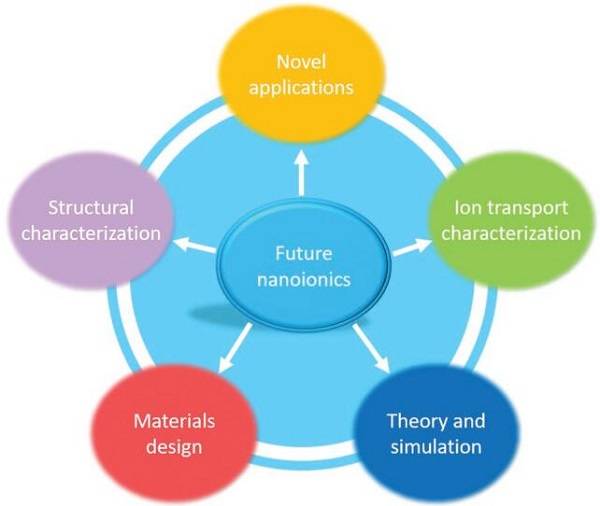 [Background introduction]
[Background introduction]
Today, ion transport in nanopores or nanochannels is common in biological, chemical, and electrochemical processes. The selective modulation of ion transport through engineered nanoporous materials is widely used in desalination, molecular or drug separation processes, and chemical and biosensors. At the same time, the efficient storage and rapid transmission of ions in nanopore electrodes is also critical for many energy storage / conversion applications such as electrochemical capacitors, batteries, and fuel cells. However, ions under nano-constraints may exhibit different behavior from the overall system. Placing ions in a solvent, they strongly interact with solvent molecules through different types of intermolecular interactions (hydrogen bonds, van der Waals forces, etc.), making them surrounded or complexed by solvent molecules, that is, solvation. The solvation process can have additional effects on nano-constrained ion transport. When the size of the nanopore is reduced to a level comparable to the size of the solvated ion itself, various abnormal ionic phenomena are observed.
At present, the research on nano-constrained ion migration involving solvation has always involved many disciplines including electrochemistry, biochemistry, and membrane separation science. Because many different disciplines involve different uses involving solvated nano-constrained ion migration, the terms used in the different disciplines are very fragmented. Therefore, in order to promote interdisciplinary communication and interdisciplinary cooperation, it is necessary to summarize and summarize the knowledge of solvated nano-constrained ion migration. In addition, the nanoporous layered membrane composed of multilayer 2D nanomaterials (2D-NLMs) is used as a unique material platform to understand solvated ion migration under nano-constraints and explore new applications related to nano-ions (Ion screening, energy storage and collection, etc.), and other new ion devices. Therefore, it is necessary to summarize and generalize the application of related solvated nano-ions in the laminar flow film of 2D nanomaterials.
[Achievement Profile]
Based on this, the Dan Li (corresponding author) team at the University of Melbourne in Australia reported a review article on solvated nanoions. First, the basic principles of solvated nano-ions involving ionic interactions and their effects on ion migration behavior are discussed. Then, the key requirements of related materials involved in solvated nanoion research are summarized, and the unique properties of 2D-NLMs are demonstrated. Then, some examples of using 2D-NLMs to solve key scientific issues related to nano-restricted ion transmission and storage are introduced to demonstrate their great potential and capabilities in nano-ion research and applications. Finally, some personal views and opinions are presented on the challenges and opportunities in this emerging field. The research results were published in the internationally renowned journal Adv. Mater. Under the title "Solvation-Involved Nanoionics: New Opportunities from 2D Nanomaterial Laminar Membranes".
[Graphic analysis]
Figure 1. Schematic diagram of research progress in this field

Figure 2. Range of ionic interaction forces caused by intermolecular forces and electrostatic gravitation
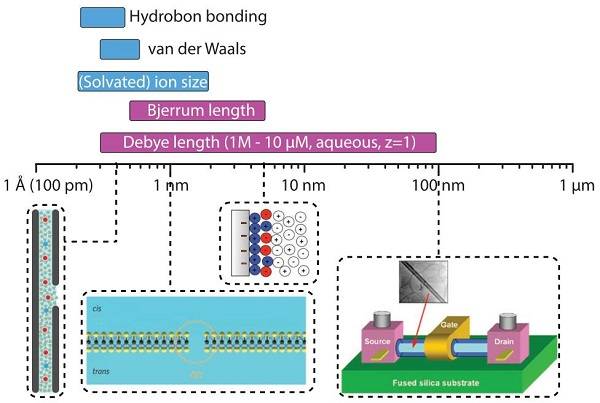
Figure 3.Preparation strategies for nanopores / nanochannels involving solvated nanoions using 2D nanomaterials
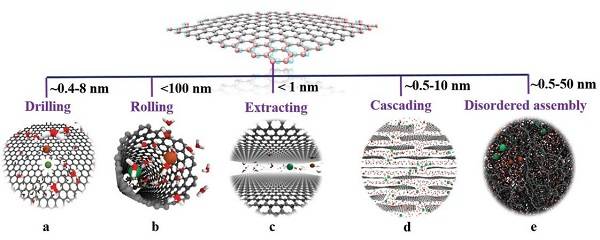
Figure 4. Understanding 2D-NLMs for ion screening
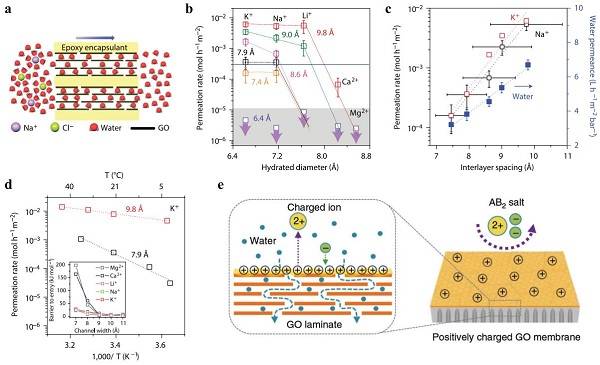
(A) Schematic diagram of horizontal transport of ions and water molecules in epoxy-encapsulated GO membranes for water treatment applications;
(B) The relationship between the penetration rate of various ions through the GO membrane and the interlayer spacing;
(C) The relationship between the permeability of K +, Na + and water and the interlayer distance;
(D) Relationship between K + permeability and temperature;
(E) Graphene (GO) GO film is coated with a positively charged polyelectrolyte and has a repelling effect on cations.
Figure 5.Ion transmission behavior in externally regulated 2D-NLMs
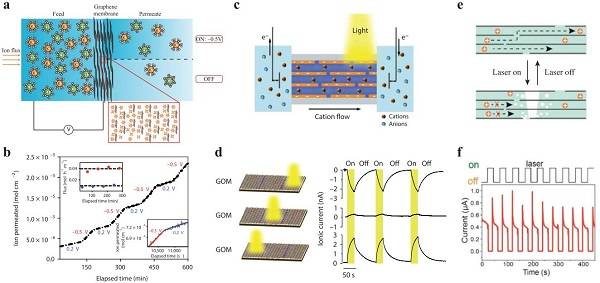
(A) Schematic diagram of the transmission of electric field regulating ions through a graphene (GO) film;
(B) the change in measured ion permeability with time when a periodic voltage is applied in a;
(C) Schematic diagram of ion migration through the GO film under light;
(D) The relationship between measured ion current and time when light is turned on and off at different locations on the film;
(E) The effect of laser-induced vapor on ion transmission in the membrane;
(F) Relationship between measured current and time.
Figure 6.Understanding nano-constrained ion storage behavior in 2D-NLMs

(A) Schematic diagram of Li + intercalation, showing the overall and partial desolvation process using different solvents;
(B) Cyclic voltammetry of the process shown in (a);
(C) Schematic diagram of cation-embedded MXene;
(D) Specific capacitance is a function of ion-MXene distance.
Figure 7: Understanding the scaling behavior of ion transport under nano-constraints using 2D-NLMs

(A) Schematic diagram of the structure of multilayer graphene (GO) film;
(B) Comparison of ion diffusivity between experiments and simulations;
(C) Schematic diagram of the device used to measure ion diffusion and conductivity;
(D) Comparison of ionic conductivity between experiments and simulations.
Figure 8.Relevant research fields involving solvated nano-ions in the future

[Summary and Prospect]
In summary, in recent years, significant progress has been made in the use of 2D-NLMs in science and technology to promote nano-ions related to solvation. However, from the aspects of material and ion migration characterization, new material design, theoretical modeling, and expected applications, there are still some key challenges and major opportunities in the future, as follows:
(1) Structural characterization: Accurate structural characterization of 2D-NLMs on all length scales from atomic, molecular, nanometer to macroscopic levels is essential to quantitatively understand the ion transport behavior under the nano-constraints of 2D-NLMs. However, because the actual 2D-NLMs system structure is much more complicated than the simplified model, making SEM, TEM, and XRD commonly used to characterize complex structures is still very challenging, so new structure characterization techniques need to be developed to obtain a more comprehensive Structure information. In addition, the structure of 2D-NLMs may change under external chemical or electrochemical stimuli, so in situ characterization techniques are needed to monitor the structural changes to study dynamic ion transport phenomena.
(2) Design of new materials: At present, research on nano-ions based on NLM is basically focused on GO-related materials and films with uniform pores or surface chemistry. There is a lack of a method for continuously adjusting the size of NLM channels based on other types of 2D nanomaterials, especially to construct 2D-NLMs with heterogeneous and possibly gradient structures is still difficult to achieve.
(3) Characterization of ion migration: At present, ion migration in 2D NLMs is mainly characterized by electrical or electrochemical methods, and the overall response of ions to external chemical or electrical potentials. During dynamic ion transmission, it is impossible to describe the temporal and spatial distribution of ions in 2D-NLMs in situ and with high resolution. In addition, since a large number of electrolyte ions may affect the overall ion transport after entering the nanopore / nanochannel, it is important to study the ion transport behavior at the entrance and its dependence on the structure, and the electrical and chemical properties of the entrance.
(4) Multi-scale and multi-mode simulation: For practical applications, ions usually propagate through a large number of nanopores in the device, so it is also important to evaluate how the behavior of ions behaves at different scales from the molecular, nanometer to device level. Given that a comprehensive understanding of ion migration in 2D-NLMs at all scales is particularly useful for guiding experiments, in addition to traditional physical-based simulations, it is also very feasible to use recent advances in machine learning to study ion migration calculations.
In summary, 2D-NLMs have great potential in ion screening and various energy storage and conversion devices. However, most of the current reports only prove the basic principles or concepts, so a lot of other research is needed to evaluate their practical limitations, scalability, and economic availability. At the same time, it is of great practical significance to explore how to use 2D-NLMs as an ion transport phenomenon under nano-constraints in simulated biology. In addition, the use of new ion devices to achieve more efficient ion separation, energy harvesting, biochemical sensing and new nanocircuits for neuromorphic computing are all challenging, but significant.
Literature link: Solvation-Involved Nanoionics: New Opportunities from 2D Nanomaterial Laminar Membranes (Adv. Mater., 2019, DOI: 10.1002 / adma.201904562)
Source of information: material cattle

| Reminder: Beijing Beike New Material Technology Co., Ltd. supplies products only for scientific research, not for humans |
| All rights reserved © 2019 beijing beike new material Technology Co., Ltd 京ICP备16054715-2号 |